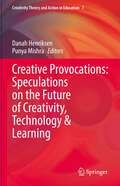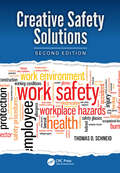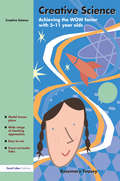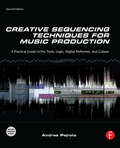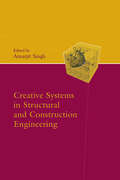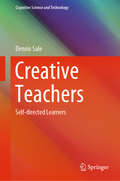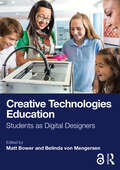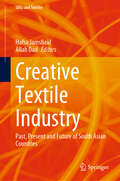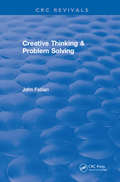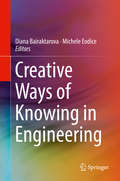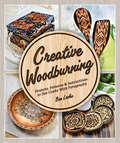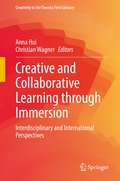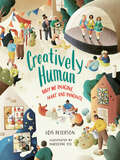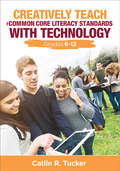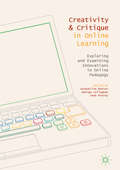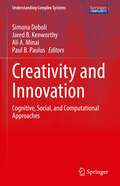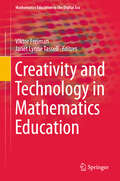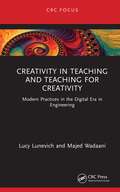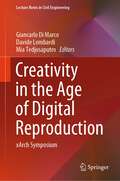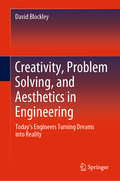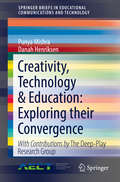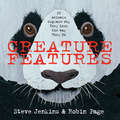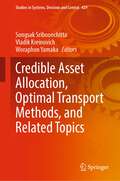- Table View
- List View
Creative Provocations: Speculations on the Future of Creativity, Technology & Learning (Creativity Theory and Action in Education #7)
by Danah Henriksen Punya MishraThis book explores the complex, yet critical, relationship between technology and creativity, specifically in educational contexts. Creativity is important for success in today’s rapidly changing, radically contingent and hyperconnected world. This is even more relevant in the context of teaching and learning—where the psychological, sociological and cultural aspects of human learning confront the challenges of a rapidly changing, technologically saturated world. Written by some of the foremost thinkers and researchers in the area of creativity and/or technology, the chapters in this volume examine the impact of recent and future technologies on creativity, teaching and learning. Individually and collectively, they help us develop an understanding of this nexus of creativity and technology for education. They offer new perspectives on this rapidly evolving future—exploring issues, paradoxes, tensions, and points of interest for creativity and technology. They position these issues in ways that consider implications for thinking, learning, teaching, and education in general.
Creative Safety Solutions (Occupational Safety And Health Guide Ser. #18)
by Thomas D SchneidIn today's rapidly changing workplace, safety and loss prevention professionals cannot always "go by the book" for the answers to new and unique problems and issues. When there is no tried-and-true solution to a problem, safety and loss prevention professionals must think outside of the box of conventional solutions and develop new and creative sol
Creative Science: Achieving the WOW Factor with 5-11 Year Olds
by Rosemary FeaseyThrough a refreshing blend of theory and practice this book provides stimulating material to develop creative approaches to science in the classroom. It includes: a range of teaching approaches that relate directly to the topic under discussion examples of pupils' work that portray how theory can be translated into practice quick off-the-shelf example model lesson plans which can be adapted. User-friendly and clearly laid out this book is a core text for primary teachers, NQTs and students who want to inject some creativity into their teaching and put that "WOW" factor back into their science lessons.
Creative Sequencing Techniques for Music Production: A Practical Guide To Logic, Digital Performer, Cubase And Pro Tools
by Andrea PejroloAn inspirational guide for all levels of expertise, Creative Sequencing Techniques for Music Production shows you how to get the most out of the four leading audio sequencers, Logic, Pro Tools, Digital Performer, and Cubase. Using real-life examples, Andrea Pejrolo demonstrates a wide range of technical and creative techniques, giving you tips and new ideas to help you take your work to the next level. If you are producing music and looking to build your skills in orchestration, composition, and mixing you will find all the techniques and practical advice you need in this book. Featuring essential tools, that are now part of the everyday creative process in a digital production environment, to give you the most recent and cutting edge techniques- including swipe-comping, time-stretching, pitch correction, elastic-time, advanced-freezing, and new software synthesizers. The material on the website contains loops, templates, audio examples, and end of chapter exercises to practice new skills, this illustrated practical guide provides all the tools you will need to give your music the vital edge. Whether you are a student or amateur aspiring to more professional results, or a professional wanting to master new skills, this book will help you to improve and take the quality of your work to the next level. *Covers all key sequencing topics such as recording and editing techniques and automation groove quantization, converters, sounds layering, tap tempo, creative meter, tempo changes, and synchronization *Teaches mixing techniques that takes advantage of plug-in technology, maximizing the use of effects such as reverb, compressor, limiter, equalizer, and much more *A website loaded with more than 90 examples of arrangements and techniques, giving you advice on how to troubleshoot those common mistakes and perfect your music production.
Creative Systems in Structural and Construction Engineering
by Amarjit SinghAn examination of creative systems in structural and construction engineering taken from conference proceedings. Topics covered range from construction methods, safety and quality to seismic response of structural elements and soils and pavement analysis.
Creative Teachers: Self-directed Learners (Cognitive Science and Technology)
by Dennis SaleThis book offers teaching/training professionals an evidence-based pedagogic guide to teaching effectively, efficiently and creatively – also known as Creative Teaching Competence. Firstly it summarizes the extensive research on human psychological functioning relating to learning and how this can be fully utilized in the design and facilitation of quality learning experiences that maximize attainment and engagement opportunities. Secondly, it demonstrates what creativity actually ‘looks like’ in terms of specific teaching practices, modeling the underpinning processes (syntax) of creative learning design. It then establishes Metacognitive Capability as the superordinate twenty-first century competency; in that this unique human attribute can significantly enhance the cognitive and motivational strategies essential for facilitating self-directed learning and wellbeing. The book helps teaching/training professionals to thoughtfully apply evidence-based knowledge and strategies to today’s challenges, such as developing self-directed learners, enhancing intrinsic motivation, utilizing technology for learning and teaching, developing curricula for twenty-first century competencies and optimally framing and developing the heightened teacher expertise required today.
Creative Technologies Education: Students as Digital Designers
by Matt Bower Belinda Von MengersenThis book is a groundbreaking exploration of how to empower students as innovative creators in an increasingly technology-driven world.With rapid advancements in Artificial Intelligence and other technologies reshaping society, this text champions the critical role of creativity in education, explaining how teachers can equip learners with skills for the future workplace and foster their enjoyment of learning through design. Bridging theory and practice, this collaborative work synthesises global research to provide actionable strategies for teachers. From multimedia and game design to Augmented Reality, robotics, 3D fabrication and more, it offers practical insights into how students can use cutting-edge technologies to design, invent, and solve problems creatively. The constructively sequenced and interconnected chapters feature evidence-based principles and real-world vignettes across all levels of schooling.Written by a team of academic experts, this open-access resource is a must-read for educators, researchers, and anyone passionate about unlocking the creative potential of the next generation using technology.
Creative Textile Industry: Past, Present and Future of South Asian Countries (SDGs and Textiles)
by Hafsa Jamshaid Allah DadThis book gives a comprehensive overview of the creative textile industry and its sectors involved in South Asian countries namely Pakistan, India, and Bangladesh. It provides basic knowledge about the textile, fabric manufacturing techniques, processing, and design method used for the development of creative textile products from the three countries in the past till the 1900s to the present 2023 and discusses the future challenges and prospects. It introduces the concept of a multi-species design process as the future need to obtain a sustainable product cycle of creative textile fabrics. The content of this book appeals to academic researchers, industrial practitioners, and policymakers who are interested in the creative textile industry in South Asia, its economics, and sustainability.
Creative Thinking And Problem Solving
by John FabianA practical new book for scientists, engineers, project leaders, and others working in the technical fields. The book adds depth, "how-to", and success to your creative thinking and problem solving.This book will allow you to sharpen your creative edge, giving you better problem solving skills. Whether you are a scientist working on breakthrough research, an engineer on the forefront of product development, or a project manager forging teams to reach and exceed goals, this new book gives you the fundamentals and advanced techniques of creative thinking to break new ground and reach higher levels of excellence.
Creative Ways of Knowing in Engineering
by Michele Eodice Diana BairaktarovaThis book offers a platform for engineering educators who are interested in implementing a "creative ways of knowing" approach to presenting engineering concepts. The case studies in this book reveal how students learn through creative engagement that includes not only design and build activities, but also creative presentations of learning, such as composing songs, writing poems and short stories, painting and drawing, as well as designing animations and comics. Any engineering educator will find common ground with the authors, who are all experienced engineering and liberal arts professors, who have taken the step to include creative activities and outlets for students learning engineering.
Creative Woodburning: Projects, Patterns and Instruction to Get Crafty with Pyrography
by Bee LockeTurn an ordinary piece of wood into a fire-burned masterpiece!If you're a crafter or an artist looking for something new and different, try pyrography. With this type of art, you use a heated instrument to burn images and words into wood. By using techniques from drawing, such as shading and stippling, you can also add depth and embellishments to your creations.It's easy to get started with pyrography–and Creative Woodburning can help you jump into this hot new craft. This book features: • An introduction to pyrography and the tools you need to get started • Expert advice on how to choose the right materials and how to create a safe working environment • 20 projects, including a jewelry box, a cutting board, a wooden egg, a clock, and a gourd birdhouse • More than 180 patterns–from animal and nature designs to borders and geometric and decorative shapes • Techniques for shading, adding color, and sealing your projectsThe power of your pyrography imagination is just between your fingertips and Creative Woodburning can help you tap into your inspiration. Even if you've never done burning of any kind before, pyrography expert Bee Locke can show you a safe yet fun way to play with fire.
Creative and Collaborative Learning through Immersion: Interdisciplinary and International Perspectives (Creativity in the Twenty First Century)
by Christian Wagner Anna HuiThis book includes instructional design and practice of how immersive technology is integrated in discipline-based and interdisciplinary curriculum design. It focuses on pedagogical models and learning outcomes of immersive learning experiences and demonstrates how immersive learning can be applied in industries. This book brings scholars, researchers and educators together around an international and interdisciplinary consolidation and reflection on learning through immersion. The originality lies in how advanced technology and contemporary pedagogical models can integrate to enhance student engagement and learning effectiveness in higher education.
Creatively Human: Why We Imagine, Make and Innovate (Orca Think #18)
by Lois PetersonCreativity is everywhere and everyone is creative. Our brains and bodies are built to make and innovate, and that instinct is as old as humanity itself. Starting when we’re babies, we draw, tell stories, invent, dance, perform, make music, among dozens of other creative acts. Did you know that our ancestors were weaving 12,000 years ago and using pigment to make paintings 17,000 years ago? Today, creativity is all around us, in public and private spaces and places all over the world. From graffiti and flash mobs to music class and TV screens, Creatively Human encourages young readers to look at the world with a creative eye. Explore the origins and impact of ideas and inventions, arts and technology, and learn about the developments and advances that change and improve the lives of everyone. It’s time to recognize and celebrate how everyone—including you—contributes to our world in so many creative ways! The epub edition of this title is fully accessible.
Creatively Teach the Common Core Literacy Standards With Technology: Grades 6-12 (Corwin Teaching Essentials)
by Catlin R. TuckerLet technology pave the way to Common Core success. Your transition to the Common Core just got easier! When you start getting creative with technology, you’ll turn your classroom into a student-centered learning environment that fosters collaboration, individualizes instruction, and cultivates essential technological literacy. This book is your road map to student success—while meeting the Common Core ELA and literacy standards. Features include: Specific recommendations for free apps and tech tools that support the Common Core Step-by-step guidelines to breaking down a Common Core standard for your grade and subject Teacher-tested, lesson ideas and teaching strategies Replicable resources, including prewriting activities and writing templates Real-life examples You don’t need to be in a 1:1 school to do amazing things with technology. With just a few devices, you can engage a whole class! Delve into the Common Core ELA standards by having students experiment creatively with the tech tools at hand for a more meaningful and resonant learning experience. "The book contains a tremendous collection of actionable ideas that can be seamlessly implemented to make a difference in all aspects of the classroom. A must-own guide that will surely be a teacher′s go-to resource to help bring the standards to life." Adam Bellow, Founder of eduTecher / eduClipper Plainview, New York "Catlin Tucker provides great ideas for student use of technology tools that cross the curriculum areas and allow the students to showcase their mastery of content. Students will love how the traditional classroom assessments are transformed!" Kathy Schrock, Educational Technologist, Adjunct Instructor Wilkes University, PA
Creatively Teach the Common Core Literacy Standards With Technology: Grades 6-12 (Corwin Teaching Essentials)
by Catlin R. TuckerLet technology pave the way to Common Core success. Your transition to the Common Core just got easier! When you start getting creative with technology, you’ll turn your classroom into a student-centered learning environment that fosters collaboration, individualizes instruction, and cultivates essential technological literacy. This book is your road map to student success—while meeting the Common Core ELA and literacy standards. Features include: Specific recommendations for free apps and tech tools that support the Common Core Step-by-step guidelines to breaking down a Common Core standard for your grade and subject Teacher-tested, lesson ideas and teaching strategies Replicable resources, including prewriting activities and writing templates Real-life examples You don’t need to be in a 1:1 school to do amazing things with technology. With just a few devices, you can engage a whole class! Delve into the Common Core ELA standards by having students experiment creatively with the tech tools at hand for a more meaningful and resonant learning experience. "The book contains a tremendous collection of actionable ideas that can be seamlessly implemented to make a difference in all aspects of the classroom. A must-own guide that will surely be a teacher′s go-to resource to help bring the standards to life." Adam Bellow, Founder of eduTecher / eduClipper Plainview, New York "Catlin Tucker provides great ideas for student use of technology tools that cross the curriculum areas and allow the students to showcase their mastery of content. Students will love how the traditional classroom assessments are transformed!" Kathy Schrock, Educational Technologist, Adjunct Instructor Wilkes University, PA
Creativity and Critique in Online Learning: Exploring and Examining Innovations in Online Pedagogy
by Jacqueline Baxter George Callaghan Jean McAvoyThis book explores emerging practices in distance education that have been facilitated by the development of educational technology. The volume examines core themes in distance education including online education at scale, embodiment in online environments, connectivity in online education and the personalisation of learning experiences within online education. The first section of the book examines online teaching tools, and explores how they are being used to enhance and promote student learning. The second looks at some of the broader challenges encountered by online teachers and those responsible for designing online learning material. While this volume will be of significant interest to distance learning universities and colleges, it will also be a valuable resource to traditional Higher Education Institutions, who are increasingly searching for innovative ways to reach and teach their students. This edited collection will be of value to scholars of online education as well as practitioners and policy makers looking to enrich their notions of online pedagogy.
Creativity and Innovation: Cognitive, Social, and Computational Approaches (Understanding Complex Systems)
by Ali A. Minai Paul B. Paulus Simona Doboli Jared B. KenworthyThis book focuses on the emergence of creative ideas from cognitive and social dynamics. In particular, it presents data, models, and analytical methods grounded in a network dynamics approach. It has long been hypothesized that innovation arises from a recombination of older ideas and concepts, but this has been studied primarily at an abstract level. In this book, we consider the networks underlying innovation – from the brain networks supporting semantic cognition to human networks such as brainstorming groups or individuals interacting through social networks – and relate the emergence of ideas to the structure and dynamics of these networks. Methods described include experimental studies with human participants, mathematical evaluation of novelty from group brainstorming experiments, neurodynamical modeling of conceptual combination, and multi-agent modeling of collective creativity. The main distinctive features of this book are the breadth of perspectives considered, the integration of experiments with theory, and a focus on the combinatorial emergence of ideas.
Creativity and Technology in Mathematics Education (Mathematics Education in the Digital Era #10)
by Viktor Freiman Janet Lynne TassellThis volume provides new insights on creativity while focusing on innovative methodological approaches in research and practice of integrating technological tools and environments in mathematics teaching and learning. This work is being built on the discussions at the mini-symposium on Creativity and Technology at the International Conference on Mathematical Creativity and Giftedness (ICMCG) in Denver, USA (2014), and other contributions to the topic. The book emphasizes a diversity of views, a variety of contexts, angles and cultures of thought, as well as mathematical and educational practices. The authors of each chapter explore the potential of technology to foster creative and divergent mathematical thinking, problem solving and problem posing, creative use of dynamic, multimodal and interactive software by teachers and learners, as well as other digital media and tools while widening and enriching transdisciplinary and interdisciplinary connections in mathematics classroom. Along with ground-breaking innovative approaches, the book aims to provide researchers and practitioners with new paths for diversification of opportunities for all students to become more creative and innovative mathematics learners. A framework for dynamic learning conditions of leveraging mathematical creativity with technology is an outcome of the book as well.
Creativity in Teaching and Teaching for Creativity: Modern Practices in the Digital Era in Engineering
by Lucy Lunevich Majed Rabhan WadaaniIn this book, the authors write about creativity in teaching and how to enhance creativity in learners. They highlight the new reality of teaching and learning in the digital era, specifically the impact of artificial intelligence, data economy, and artificial minds on modern teaching practices, curriculum design, and the role of teachers in classrooms. Creativity in Teaching and Teaching for Creativity: Modern Practices in the Digital Era approaches human intelligence as a universal gift. It emphasizes that the creativity of human beings is not only a natural quality, but one that can be enhanced as a result of learning. The book suggests new teaching models and approaches and discusses how the role of teachers in the classroom has fundamentally changed, emphasizing the emotional connection between students and teachers. The book will find interest among higher education policymakers who believe in the transformation of the education industry, research scholars who are pursuing their Ph.D. in the fields of education technology and education and learning, as well as those working in the area of education technology and artificial intelligence.
Creativity in the Age of Digital Reproduction: xArch Symposium (Lecture Notes in Civil Engineering #343)
by Davide Lombardi Giancarlo Di Marco Mia TedjosaputroInspired by this symposium we would like to rethink and provide an insight about the use of new technologies in architecture and design. The consideration spans over (but not limited to) computational design, virtual experience, digital fabrication, artificial intelligence and sustainability/environment. Readers of the proceedings will benefit from discussions on how adoption of new technologies can benefit the Construction Industry rather than just for the sake of leveraging new technologies. The book targets scholars and high-education level students, as well as Ph.D.s which research falls into the broad realm of digital design.
Creativity, Innovation, and Entrepreneurship Across Cultures: Theory and Practices (Innovation, Technology, and Knowledge Management)
by Elias G. Carayannis Igor N. DubinaThe aim of this volume is to further develop the relationship between culture and manifold phenomena of creativity, innovation and entrepreneurship in order to promote further and better understanding how, why, and when these phenomena are manifested themselves across different cultures. Currently, cross-cultural research is one of the most dynamically and rapidly growing areas. At the same time, creativity, inventiveness, innovation, and entrepreneurship are championed in the literature as the critical element that is vital not just for companies, but also for the development of societies. A sizable body of research demonstrates that cultural differences may foster or inhibit creative, inventive, innovative and entrepreneurial activities; and each culture has its own strengths and weaknesses in these regards. Better understanding of cultural diversity in these phenomena can help to build on strengths and overcome weaknesses. Cross-cultural studies in this field represent a comparatively new class of interdisciplinary research. This is a field where cultural, sociological, psychological, historical, economic, management, technology and business studies closely intersect. In this book, a global team of researchers representing Europe, Asia, and the Americas review, analyze, structure, systematize and discuss various concepts, assumptions, speculations, theories, and empirical research which focus on the effect of national cultures on creativity, invention, innovation, and entrepreneurship. They argue that national culture is not only an extremely important determinant of innovation and business development, but also demonstrate that some aspects relating to these phenomena may be universal among all cultures, thereby identifying those factors that may easily be transferred across cultures from those that are unique to their specific context.
Creativity, Problem Solving, and Aesthetics in Engineering: Today's Engineers Turning Dreams into Reality
by David BlockleyThis book illuminates what engineering is and how it relates to other disciplines such as art, architecture, law, economics, science, technology, and even religion. The author explains, from an intrinsic as well as descriptive perspective, why engineering is essential for our collective well-being, and how, like medicine, it is undertaken by people, and for people, to improve the human condition. He brings out the 'magic' of engineering practice as well as addressing the darker aspects such as warfare and the misuse of the internet. A too commonly held view assumes that the practice of engineers is a cold, purely quantitative and wholly technical enterprise of applying know science, and devoid of creativity or aestheticism. In 2013 the United States National Academy of Engineering launched a campaign called “Changing the Conversation, Messages for Improving Public Understanding of Engineering” with four messages to impart about engineers: that they make a world of difference; are creative problem solvers; that they help shape the future, and are essential to health, happiness, and safety. In this volume, Professor Blockley incorporate these messages into an engaging exposition of engineering accomplishment in all of its evolving diversity, from the technician to the academic research engineer, illustrating the continuum of thinking and purpose from the fixer of the gas boiler to the designers of the A380 and the iPhone.
Creativity, Technology & Education: Exploring their Convergence (SpringerBriefs in Educational Communications and Technology)
by Danah Henriksen Punya MishraIn this collection of beautifully written essays, Mishra, Henriksen, and the Deep-play Research Group challenge myths about technology and creativity, debate time-honored instructional practices, and play with new ideas for schools to care for and nurture, rather than constrain, creativity. These essays are provocative . . . refreshing, [and] insightful --Dr. Yong Zhao, Foundation Distinguished Professor, University of Kansas and Fellow, Mitchell Institute for Health and Education Policy, Victoria University, Australia. What is creativity? Why is it important? What does it look like across different disciplines and contexts? What role does technology play, if any, in the creative process? And finally, what do creativity and technology have to do with education? These are the questions that underlie the collection of articles in this book. These essays provide a broad analytic frame for thinking about creativity, technology and education and describe classroom examples as well as strategies for evaluating creative artifacts and creative environments. All of these are grounded in specific examples from across a wide range of disciplines and contexts--art, mathematics, engineering, computer science, graphic design, architecture, science to name just a few. The final essays take a broader perspective on creativity and technology focusing both on our highly inter-connected YouTube world but also possibilities for the future. Creativity, Technology & Education: Exploring their Convergence is a vital resource for educators and practitioners as they seek to incorporate creative work and thoughtful pedagogy in their personal and professional lives.
Creature Features: Twenty-Five Animals Explain Why They Look the Way They Do
by Steve Jenkins Robin PageDear axolotl: Why do you have feathers growing out of your head? Axolotl: They aren't feathers—they're gills! They let me breathe underwater. Let's face it. Even as babies, we humans pay close attention to faces. Observing another person's features and expressions tells us whether they are happy, angry, excited, or sad. And when we look at an animal, it's hard not to imagine that its face is communicating human feelings. This isn't true, of course. Squinty eyes, an upturned mouth, or another odd expression is probably there because, in some way, it helps that animal survive. Packed with many cool facts and visuals on where certain animals live and what they eat, this book captures twenty-five humorous—and very true—explanations of why animals look the way they do in order to exist in this world.
Credible Asset Allocation, Optimal Transport Methods, and Related Topics (Studies in Systems, Decision and Control #429)
by Vladik Kreinovich Songsak Sriboonchitta Woraphon YamakaThis book describes state-of-the-art economic ideas and how these ideas can be (and are) used to make economic decision (in particular, to optimally allocate assets) and to gauge the results of different economic decisions (in particular, by using optimal transport methods). Special emphasis is paid to machine learning techniques (including deep learning) and to different aspects of quantum econometrics—when quantum physics and quantum computing models are techniques are applied to study economic phenomena. Applications range from more traditional economic areas to more non-traditional topics such as economic aspects of tourism, cryptocurrencies, telecommunication infrastructure, and pandemic. This book helps student to learn new techniques, practitioners to become better knowledgeable of the state-of-the-art econometric techniques, and researchers to further develop these important research directions
